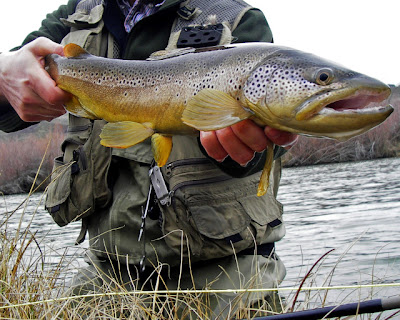I will admit in the past Spring has never been my favorite season. I know the ideal image of spring brings to mind thoughts of fresh sprouting green grass, soft gentle rains, budding willows, and freshly bloomed daffodils, but it seems that the reality is often closer to dull gray skies, harsh winds, and sticky brown mud...everywhere. Okay that may have been the pessimist in me coming out. But in the past I have always felt that Spring was a bit overrated as a season, and just a necessary transition that must be endured until summer finally arrived. As a fly fisherman though I have garnered a whole new found respect for that formerly overrated season, thanks to one tiny bug. The Blue Wing Olive.
 |
A freshly hatched BWO rides along the calm surface.
|
The reality is that BWO's can have a presence throughout the year, and make a strong reappearance in the fall, but their spring time arrival is about as welcome an event as you can have for both fly fishermen and fish alike. Other hatches get all the hype, but these little bugs can make fish go bonkers, and in weather conditions that used to rank right up there with the reason I felt spring was over rated, these bugs flourish. If you ask me now what days in the spring I look forward to it would be a fairly cold 45-50 degree day with overcast skies spitting a few rain showers, with even a little breeze thrown in. Of course not enough of a breeze to make casting a fly rod difficult, but just enough to push those little sailboat profile mayflies around on the water, and concentrate them between a swift current seam and a grassy bank. Natures way of creating an all-you-can-eat buffet for hungry trout coming off a cold lethargic winter of snacking on whatever requires the least amount of energy to be expended.
As I stood in the midst of a frenetic river last week watching one of the most amazing hatches of Blue Wing Olives come off, it reminded me of watching popcorn, except,
unless you really like popcorn, a bit more exhilarating. There is the quiet calm where the kernels sit quietly in the slowly heating oil. It can be hard to tell when this stage starts as all the action is underwater, hidden from the anglers eye. It may look like the water is quiet, but underneath the surface things are starting to happen.
Then the oil starts to sizzle and pop. Like when you start seeing those first rises. Usually just dorsal fins, or tails as the fish take the rising nymphs as they swim for the surface. Things are getting more heated now. And the first kernels are starting to crack. You hear that first pop in the pan, or you see that first dun on the surface gliding slowly along drying it's wings. A fish here and there begin rising for the later stage emergers, and a couple are even up on the few duns floating down river.
Suddenly, like that moment that the kernels begin exploding, not one at a time, but at a constant thunderous rate, things get bananas. In that run you could have sworn was void of any fish just minutes before there are more rises than you can count. One look at the water and you see exactly why. The evidence is littering the surface as the small sailboat profiles are everywhere. Where once a sporadic bug or two drifted alone, there are literally hundreds...no thousands! It gets crazy. You hope this crescendo lasts for a while. The fish are going nuts and so are you. In the right conditions (see my new favorite spring weather above) this stage can last quite some time, and when it does I count my lucky stars or what ever that saying is.
Then just as quickly as they started popping things subside. Again you can only see a couple duns drifting on the surface. Some of the stragglers, like those half popped old maids in the popcorn bowl, are struggling to make it off the water. Something has happened in this process for them and they aren't going to make it. Like those half or unpopped kernels that settle and collect in the bottom of the bowl, these wounded and battered bugs get pushed helplessly by the current into protected pockets or up against a grassy bank where they become more concentrated. Much of the surface activity has subsided as well, but a few of the wiser and larger fish are still around. Tucked into those little nooks where those crippled and half drowned mayflies have been rounded up against their will they sip away quietly. It's the tail end of the action, but the careful eye of an observant angler knows there is still action to be found in seeking out these protected areas and keeping a keen eye out for those stealthy rises. Then the river is quiet, waiting silently for the next out burst.
I am no entomologist, and certainly no fly fishing expert. I just know I love to watch a good hatch develop and reap the rewards that come along with it. There are plenty of frustrating moments in this process for myself. But it is what keeps me coming back. If things were always easy, then what would be the point? These BWO hatches have given me some great study material this spring. I have learned, and I have gone back to the drawing board. Many times, but it's all part of the process.
 |
| A nice fish that came early in the hatch on an early stage emerger pattern. |
 |
| This fish fell for a more standard upright wing pattern mimicking the BWO Dun |
 |
| One of those fish spotted after the hatch sipping cripples that collected along a shallow grassy bank. |










